I had a great time and learned so much as a guest of Honsha and their Executive Development Mission trip to Japan in October. The formal site visits to factories and companies were great, but a lot of the learning and reflection came through discussions with people on the bus and train and there were moments of serendipity along the way.
I'll blog more about some of the site visits and the formal learning in future posts, but I was reminded of a sushi-eating adventure – thanks to Katie Anderson‘s recent article for the LEI Lean Post (“Roll”-ing Out Lean at Kura Sushi) and it's a good follow up to our recent podcast.
As Katie wrote about, Kura Sushi is a chain of conveyor belt sushi restaurants in Japan (and, as I've learned, in the U.S., so I want to visit one in Texas. Edit — I did, see my post about it).
Conveyor belt sushi is, in a way, more like fast food (or “fast casual”) sushi — it's a different experience than a skilled sushi chef standing across the counter from you, crafting and handing you one piece of sushi at a time (like the famed Jiro and this sushi chef I also blogged about before). There's a time and a place for a quality fast food hamburger (like In-N-Out) and there's a time for a nice hamburger at a sit-down steak restaurant.
I've eaten at a number of conveyor belt sushi places – in Japan, in the U.S., and in England (YO! Sushi). Here's a video I embedded in a 2009 blog post about YO! Sushi, which is not unlike many of the more casual places in Japan:
The “standardized work,” if you will for conveyor belt sushi places like this is pretty simple:
- See something you like on the conveyor
- Take the plate
- Eat the sushi
- Stack your plates
- At the end of the meal, the plates are added up (different colors represent different prices) and you pay accordingly
Yes, you could grab items from the conveyor as they went by, but there was also a process for placing a special custom order through a screen, as shown below:
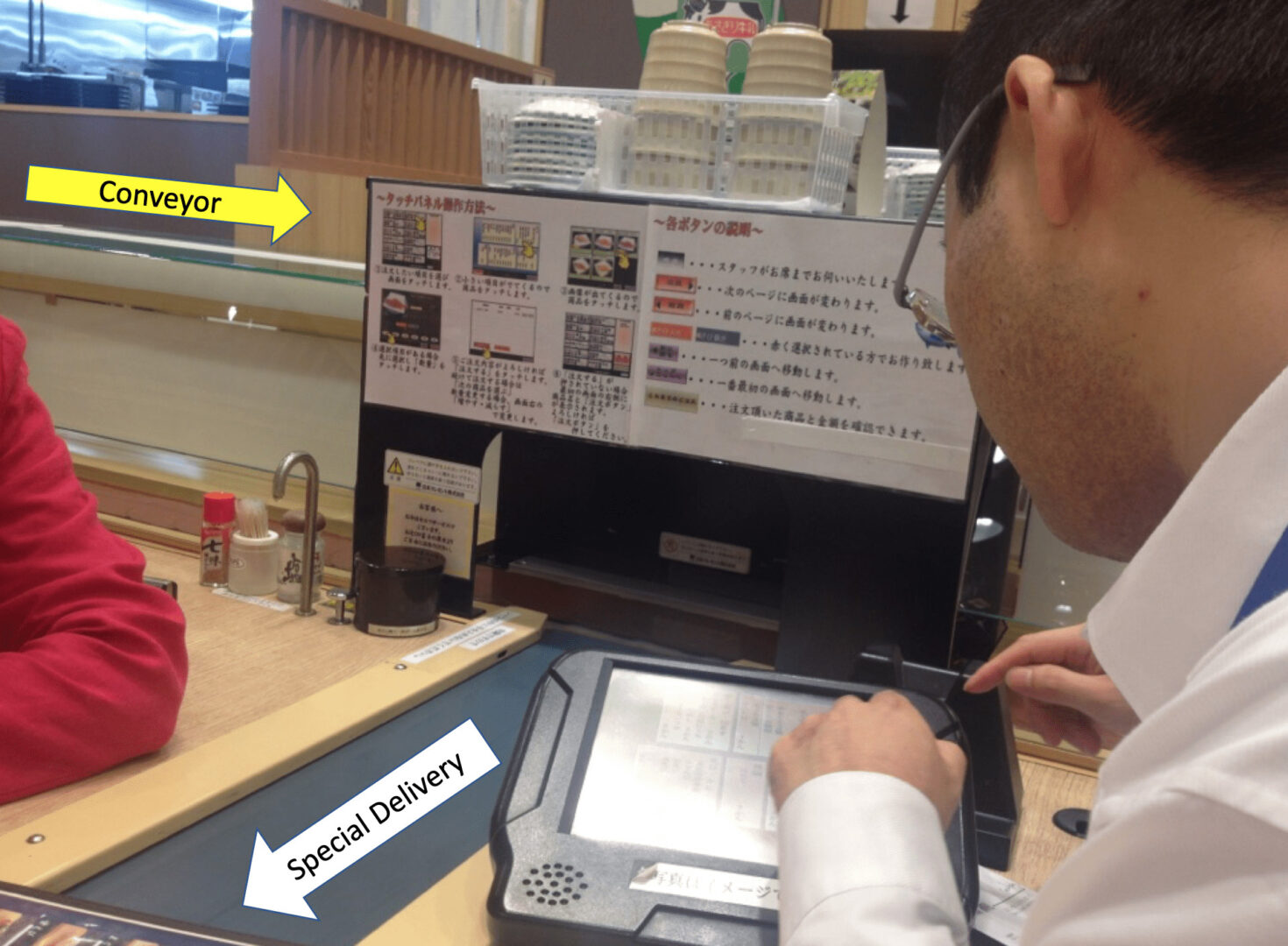
In that photo, there's a conveyor belt running from left to right. You could take any of that sushi as it went by. But the special orders were routed directly to your table via the black conveyor belt that came directly to your table. There was a different pathway for custom orders.
In subsequent trips to Japan, I've usually had conveyor belt sushi once (or more) each time. It's usually the more casual counter-style grab-what-you-like approach.
But, with Honsha here in 2018, our group was taken to a sit down conveyor belt sushi place outside of Nagoya — different than the 2012 place.
There was a screen for placing drink orders and special sushi orders (or other food), but with newer technology. Our group sat at tables, but there was also counter seating for individuals:
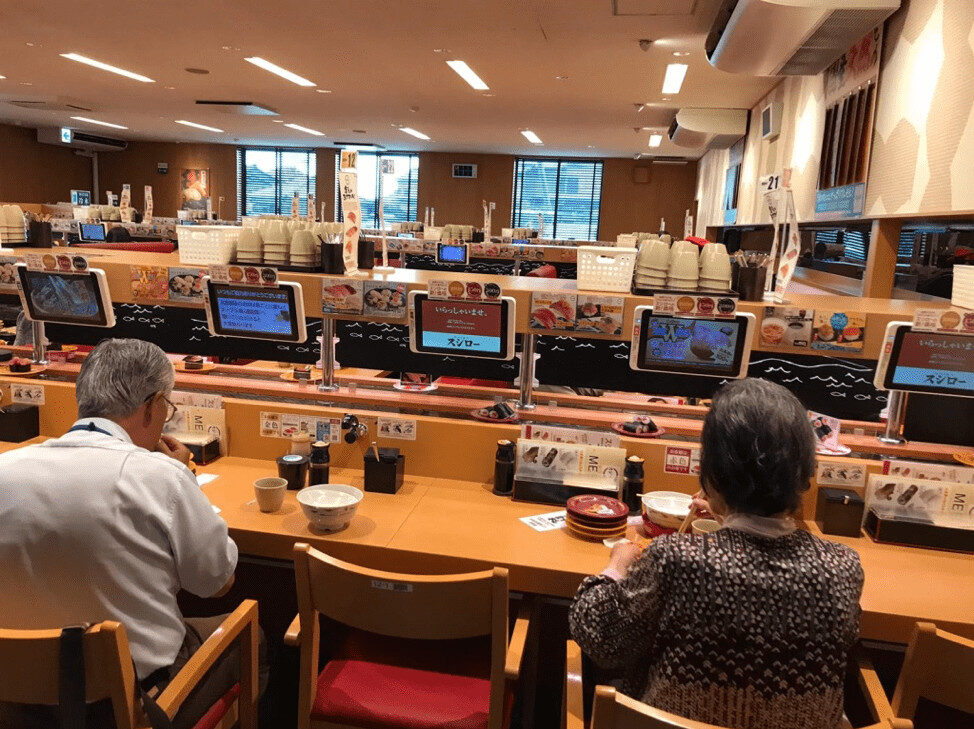
Here is the view from our group's table:
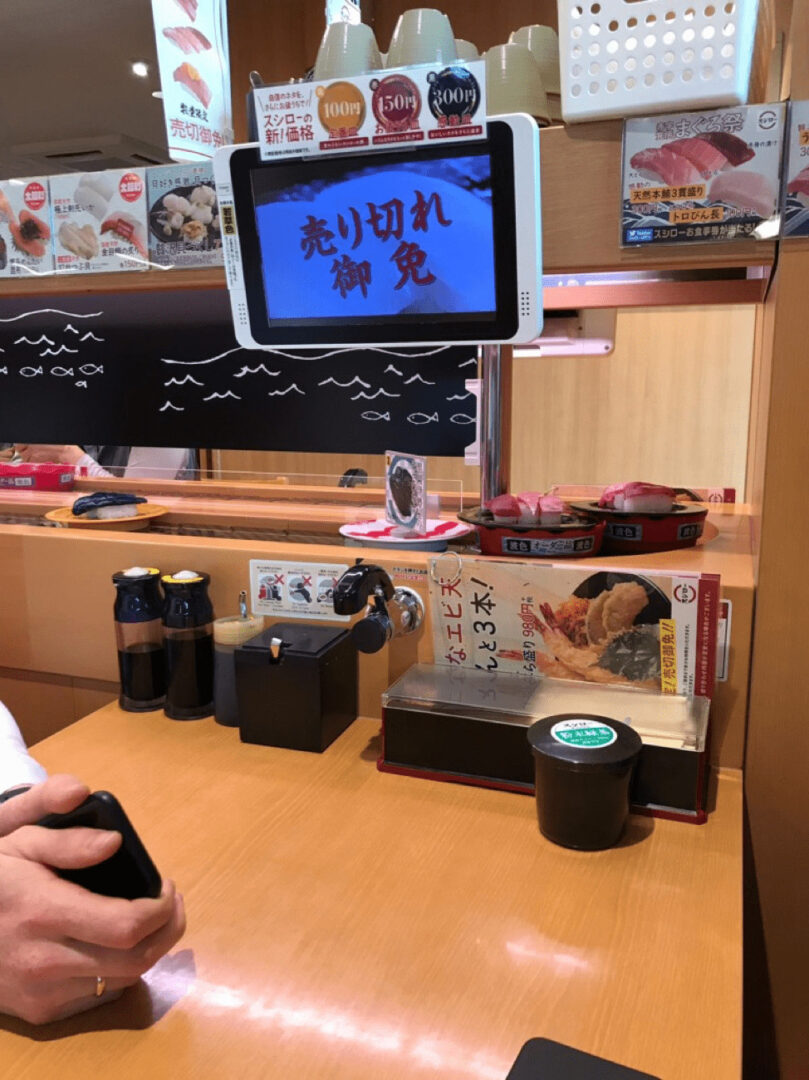
You can see the ordering screen and all of the usual things you see on the table: soy sauce dispensers, green tea powder, the hot water dispenser, chopsticks.
So, we knew we could place orders. And, you could generally grab sushi from the conveyor, but we weren't given any other standardized work by the restaurant or our guides. There was no procedure posted at the table, like the one I saw later in the week at a “takoyaki” (octopus balls) restaurant where you cook your own food at the table:
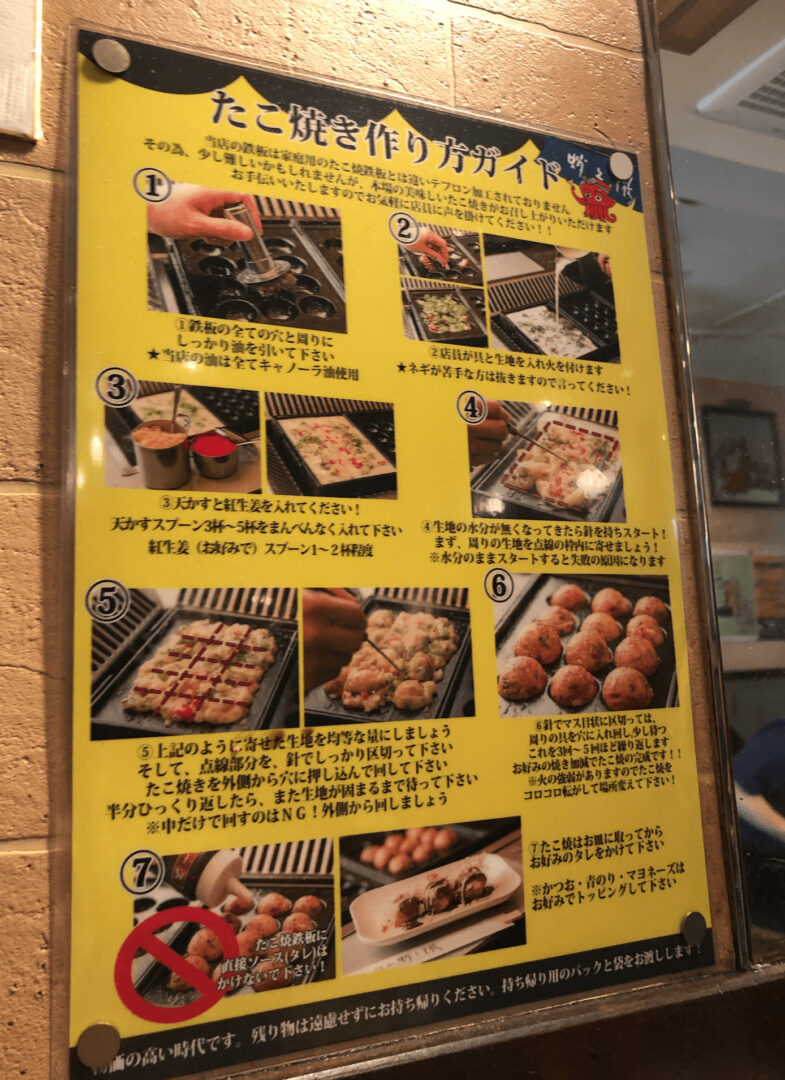
I don't read Japanese, but the pictures help a lot (and that's one reason it's good to use pictures in your standardized work documents in a workplace).
But, anyway, back to sushi. I was hungry when we arrived. There's no reason to wait with conveyor belt sushi — see something, grab something, eat something. Yum, that looks good — I'll eat that to tide me over until the special orders arrive.
Our Embarassing Mistake
What we didn't learn until a few minutes into the meal was that the standardized work was different there! Special orders weren't delivered directly to your table. Special orders were plates on a special red base.
Oops!
People at our table (and other tables in our group) were making the mistake of taking plates off of the red bases. We were taking food that had been ordered by people at other tables!
How embarrassing! Talk about disturbing the harmony.
One of the servers came and scolded us (and/or tried to explain) but did so in Japanese. That didn't help much, but it did make us cautious and we stopped grabbing plates. One of our guides / translators came over and explained.
As shown below, regular plates were OK for anyone to take… red bases were not OK to take unless they were yours:
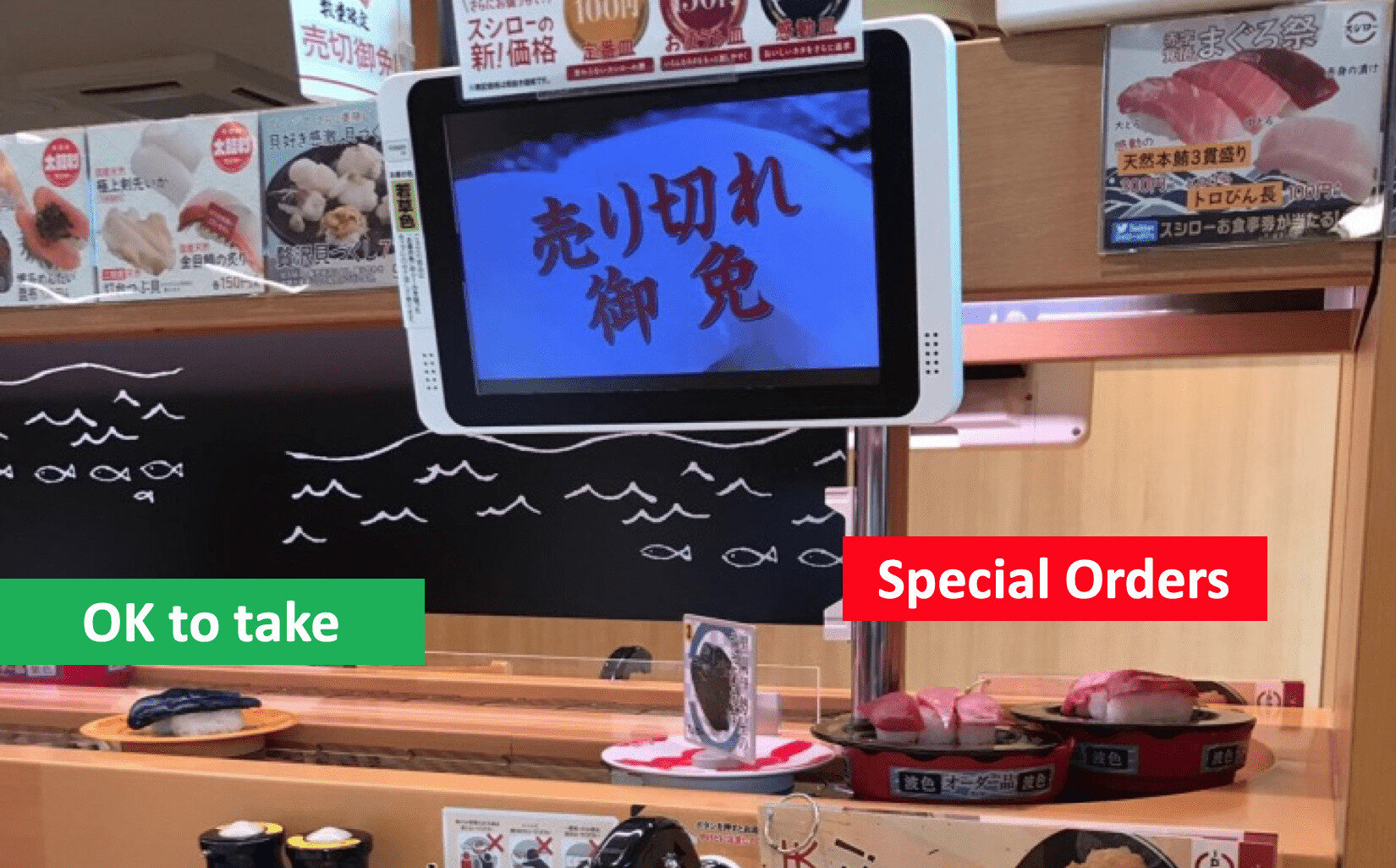
Well, now we knew. I had thought the red bases were just more expensive (which was true, but I was wrong to take them).
The standardized work here was more like:
- If it's on a plate with no base, you can take it and eat it
- If you place a special order, as your order arrives (on red bases), the screen will flash and play a song / chimes to let you know your order is almost there
- You look for the plate with the symbol for your table as the visual indicator that these are your items to follow
- Your bill is a combination of stacked plates that you grabbed and your special order plates
The good news is that, since payment is based on the plates on your table, other people weren't stuck paying for the special orders that we mistakenly grabbed. It just delayed their food and created chaos for the restaurant, and we felt horrible.
I was embarrassed — I would have been more cautious and would have asked more questions if I had never been to a place like this.
One of the servers later said, “It's OK… some of our older Japanese customers get confused too.” Hmmm, I guess that makes me feel better? It sounded like the Japanese equivalent of somebody in the American south saying “Well, bless your heart” (which isn't always meant to be as nice as it sounds).
The Power of Mental Models
It made me think about mental models and our assumptions about how things work. Sometimes, having some experience is worse than having no experience. I can see why companies like Southwest tend not to hire people with experience working at other airlines. It can be hard to change your mental models, whether that model is “it's OK to take plates from the conveyor belt” or “my employees don't have ideas for improvement.” We tend to get stuck in a way of thinking.
The mental models of Lean aren't complicated, such as “we believe our employees all have ideas for improvement” and “leaders will be coaches and facilitators instead of bosses who have all the answers.” But it can be very difficult to unlearn what we've already learned and “know” about management.
I'm fortunate that I learned about Lean, Deming (and Wheeler) very early in my career. That's been both a blessing and a curse. There are certain mental models that I take for granted and I have to really force myself to remember sometimes that people I'm working with are having to unlearn things (or the world reminds me of this).
So I think about the sushi restaurants — which is a better process? The direct conveyor to your table or the red bases? Which is error proofed? Which makes it easy to do the right thing? Which makes the right thing obvious? I'd argue the restaurant I visited in 2012 has a better design.
A system that's not error proofed requires a different level of standardized work, training, and supervision.
When we got back on the bus, Darril Wilburn (from Honsha) basically apologized to the group for not setting us up for success. It would be easy for Darril, the restaurant, or leaders in any workplace to say things like, “But you should have known!!” You should have been more careful! You should have pulled the andon cord!”
One mental model from Toyota that Darril has shared in the past (and re-emphasized during the trip) was the idea that:
“Leaders have a responsibility to create a system in which employees can be successful.”
– Darril Wilburn
It's easy to get upset and yell and to blame. It's harder to create an error proofed system. It's also pretty rare to see leaders (like Darril) take responsibility for systems and work together with employees to improve.
I'm quite certain that, during future trips, Darril and the Honsha team will make sure visitors are properly prepped on the standardized work of any sushi restaurant (or another unfamiliar environment). I don't blame Darill or his team — they also didn't know what they didn't know (and didn't know what we didn't know as participants). We're all human.
Here is a follow-up post about my experience at a different Japanese conveyor belt restaurant that has a location near Dallas.
Please scroll down (or click) to post a comment. Connect with me on LinkedIn.
Let’s work together to build a culture of continuous improvement and psychological safety. If you're a leader looking to create lasting change—not just projects—I help organizations:
- Engage people at all levels in sustainable improvement
- Shift from fear of mistakes to learning from them
- Apply Lean thinking in practical, people-centered ways
Interested in coaching or a keynote talk? Let’s start a conversation.










Discussion on LinkedIn:
And Katie added:
This story prompted me to consider the lack of employee to customer interaction Graban seemed to experience. Had there been a hostess or greeter at the door to not only walk people to their seats but give a brief introduction of how this conveyor belt system works, they could have prevented foreseeable issues. This lack of seemingly human interaction is something that I have found to be growing quite quickly. These past couple years have been the downfall of malls due to a decrease in foot traffic and consumers taking the “more convenient” route of online shopping. This eliminates the ability to discuss merchandise options with store employees and takes away from the shopping experience of face-to-face customer service. With an increase in online sales and restaurants with DIY dining, this leads to the elimination of physical jobs and an increase in reliance on technology. What would happen if the conveyor belt stopped working? or if the Nordstrom website had a glitch? It seems like this is the future for consumer buying and purchasing habits, but what this lacks are a human connection and physical person-to-person contact.
As I wrote about here, at Kura Sushi in Texas, the server asked if it was our first time there. I said, “No,” and he walked through how to grab the plates (but not the tray/lid device), how to put finished plates in the chute, and how to place special orders (explaining the tablet and the top conveyor).
I get frustrated when I’m in a store and the staffing levels in the store floor or at the register seem so low as to be counterproductive. “Any fool can cut costs,” is a phrase that’s attributed to many different people.
I loved my first experience with conveyor belt sushi in Seattle last summer while attending the Lean Coaching Summit there put on by LEI. It was a complete surprise to me — in New England we don’t seem to have them. Are we behind the times here? I loved the experience because it illustrated so many lean principles and methods, flow and pull, signaling, standard work as Mark has described, as well as the weaknesses in such systems, and also examples of the not so lean. A colleague I met at the summit suggested the sushi place, and I was flabbergasted when we walked in. Anyway, there wasn’t much signage to explain the process, but thankfully my new colleague had prior experience and showed me the way. This place had a separate conveyor for special orders, but we had to deduce this after watching for a while. We wondered how much food waste is generated by pushing sushi onto the regular conveyor belt that doesn’t get taken, and whether quality is affected by time on the conveyor.
Separate thought from that summit, to another point in this blog of Mark’s, about setting people up to succeed. John Shook opened up the 2nd day of the summit, with a sort of talk show format with a Japanese man who his original mentor at Toyota in Japan (sorry I can’t remember his name). Only his mentor was late for the start. After joking about it a little, John took responsibility for not helping his mentor succeed in this activity, by apparently not giving clear enough information on the timing, place, directions, etc. It was clear he was being sincere about this, not joking. His mentor arrived a short time later and engaged with John in a very enjoyable repartee about coaching, mentoring, and learning. The impact on me of John doing this was significant – it was an aha moment. It lowered my stress level over the late start, helped me not think negatively about the mentor’s lateness, and increased my respect for John who did this so naturally and authentically.
Hi Tom – Thanks for commenting. I haven’t see a lot of “conveyor belt sushi” around the U.S. it’s still pretty rare and a bit of a novelty, I think.
In terms of food production, the special orders seem like a good example of “pull,” where food isn’t created (or finished) unless a customer orders it. That said, the restaurant orders fish and ingredients based on forecasts or predictions of demand. That’s not really pull.
For the stuff going around on the conveyors, I don’t think that’s really “push” either. I think of push as building to a schedule and sticking to it regardless of demand or how much inventory piles up. On the conveyor, it seemed like there was an inventory level set, and then the items were replenished based on customer pull. But, I bet as the place gets less busy toward the end of the night, the “standard WIP” on the conveyor is probably reduced.
I’d be curious to know:
1) How long is food allowed to circulate before it’s taken off… are there food safety concerns or freshness concerns? You don’t want sushi to be ice cold… and I’m guessing the safety is based more on the sourcing, the freshness, and the handling.
2) How much food is wasted at the end of the night because customers didn’t pull it from the conveyor? Do they offer “end of night happy hour” specials, thinking it’s better to sell it at a lower price than to not sell it at all? You could have a lot of data to use at a restaurant like this.
Thanks for sharing the story about John Shook and his mentor — that must have been Isao Yoshino.